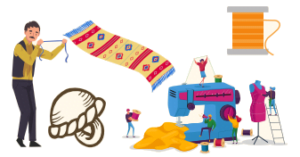A Career in Textile Design
Introduction to Textile Design
Have you ever looked around at the different colorful fabrics in a clothing store? What about the fabric? Was the fabric made of cotton or wool or woven or knitted? What about the colors? All this and more is what textile design deals with.
 Depending on the geographical location and period of time, every culture has its own distinct textiles with favorite fibers, patterns, and colors. Textiles go back thousands of years, with cottons and silks from India and China dating as early as 5000 BC. When trade networks developed between European, Middle Eastern, and Asian countries, textiles became valuable commodities. We don’t know who designed these early textiles, but we do know that someone was making decisions about weaves, colors, and patterns.
Depending on the geographical location and period of time, every culture has its own distinct textiles with favorite fibers, patterns, and colors. Textiles go back thousands of years, with cottons and silks from India and China dating as early as 5000 BC. When trade networks developed between European, Middle Eastern, and Asian countries, textiles became valuable commodities. We don’t know who designed these early textiles, but we do know that someone was making decisions about weaves, colors, and patterns.
 Textile design thus is the process of planning and producing a fabric’s appearance and structure. Textile designers dream up designs that are woven or knitted into cloth or printed on fabric. They might suggest types of thread to weave together for a specific look and feel or create patterns that adorn a fabric surface. Textile designers might also specify a dyeing method, or the use of dyes to color fibers or fabric surfaces to achieve a desired effect.
Textile design thus is the process of planning and producing a fabric’s appearance and structure. Textile designers dream up designs that are woven or knitted into cloth or printed on fabric. They might suggest types of thread to weave together for a specific look and feel or create patterns that adorn a fabric surface. Textile designers might also specify a dyeing method, or the use of dyes to color fibers or fabric surfaces to achieve a desired effect.
 Textile design is the discipline that concerns itself with the ideation, creation and modification of textiles, which are materials made through the process of linking and joining. Finding application in various fields such as fashion, home decor, lifestyle, automobile and other service industries, textiles form a substantial part of our daily interaction with the tangible world.
Textile design is the discipline that concerns itself with the ideation, creation and modification of textiles, which are materials made through the process of linking and joining. Finding application in various fields such as fashion, home decor, lifestyle, automobile and other service industries, textiles form a substantial part of our daily interaction with the tangible world.
 With its abundant resources and historical textile heritage, India remains a global competitor of textile design and production. What makes the Indian textile industry different from its global competitor is the integration of its indigenous and traditional craft practices in its textile production. These multitude of regionally-exclusive craft practices that are diverse in idea and methodology contribute to the richness of the Indian textile sector and makes one question the distinction between craft and design. Upon close enquiry, it is evident that these textile practices are the pioneers of sustainability and sustainable living as they took shape before the industrial revolution.
Textile design and its understanding throughout the past decade have evolved more than just as a medium of ornamentation but as a practice that supports inter-disciplinary participation and development; and as a core field of knowledge that facilitates the functioning and efficiency of various industries such as fashion, interior, healthcare and many more that rely on it.
With its abundant resources and historical textile heritage, India remains a global competitor of textile design and production. What makes the Indian textile industry different from its global competitor is the integration of its indigenous and traditional craft practices in its textile production. These multitude of regionally-exclusive craft practices that are diverse in idea and methodology contribute to the richness of the Indian textile sector and makes one question the distinction between craft and design. Upon close enquiry, it is evident that these textile practices are the pioneers of sustainability and sustainable living as they took shape before the industrial revolution.
Textile design and its understanding throughout the past decade have evolved more than just as a medium of ornamentation but as a practice that supports inter-disciplinary participation and development; and as a core field of knowledge that facilitates the functioning and efficiency of various industries such as fashion, interior, healthcare and many more that rely on it.
Design Assistant (Textile/Apparel): Career Pathway
 Depending on the geographical location and period of time, every culture has its own distinct textiles with favorite fibers, patterns, and colors. Textiles go back thousands of years, with cottons and silks from India and China dating as early as 5000 BC. When trade networks developed between European, Middle Eastern, and Asian countries, textiles became valuable commodities. We don’t know who designed these early textiles, but we do know that someone was making decisions about weaves, colors, and patterns.
Depending on the geographical location and period of time, every culture has its own distinct textiles with favorite fibers, patterns, and colors. Textiles go back thousands of years, with cottons and silks from India and China dating as early as 5000 BC. When trade networks developed between European, Middle Eastern, and Asian countries, textiles became valuable commodities. We don’t know who designed these early textiles, but we do know that someone was making decisions about weaves, colors, and patterns.
 Textile design thus is the process of planning and producing a fabric’s appearance and structure. Textile designers dream up designs that are woven or knitted into cloth or printed on fabric. They might suggest types of thread to weave together for a specific look and feel or create patterns that adorn a fabric surface. Textile designers might also specify a dyeing method, or the use of dyes to color fibers or fabric surfaces to achieve a desired effect.
Textile design thus is the process of planning and producing a fabric’s appearance and structure. Textile designers dream up designs that are woven or knitted into cloth or printed on fabric. They might suggest types of thread to weave together for a specific look and feel or create patterns that adorn a fabric surface. Textile designers might also specify a dyeing method, or the use of dyes to color fibers or fabric surfaces to achieve a desired effect.
 Textile design is the discipline that concerns itself with the ideation, creation and modification of textiles, which are materials made through the process of linking and joining. Finding application in various fields such as fashion, home decor, lifestyle, automobile and other service industries, textiles form a substantial part of our daily interaction with the tangible world.
Textile design is the discipline that concerns itself with the ideation, creation and modification of textiles, which are materials made through the process of linking and joining. Finding application in various fields such as fashion, home decor, lifestyle, automobile and other service industries, textiles form a substantial part of our daily interaction with the tangible world.
 With its abundant resources and historical textile heritage, India remains a global competitor of textile design and production. What makes the Indian textile industry different from its global competitor is the integration of its indigenous and traditional craft practices in its textile production. These multitude of regionally-exclusive craft practices that are diverse in idea and methodology contribute to the richness of the Indian textile sector and makes one question the distinction between craft and design. Upon close enquiry, it is evident that these textile practices are the pioneers of sustainability and sustainable living as they took shape before the industrial revolution.
Textile design and its understanding throughout the past decade have evolved more than just as a medium of ornamentation but as a practice that supports inter-disciplinary participation and development; and as a core field of knowledge that facilitates the functioning and efficiency of various industries such as fashion, interior, healthcare and many more that rely on it.
With its abundant resources and historical textile heritage, India remains a global competitor of textile design and production. What makes the Indian textile industry different from its global competitor is the integration of its indigenous and traditional craft practices in its textile production. These multitude of regionally-exclusive craft practices that are diverse in idea and methodology contribute to the richness of the Indian textile sector and makes one question the distinction between craft and design. Upon close enquiry, it is evident that these textile practices are the pioneers of sustainability and sustainable living as they took shape before the industrial revolution.
Textile design and its understanding throughout the past decade have evolved more than just as a medium of ornamentation but as a practice that supports inter-disciplinary participation and development; and as a core field of knowledge that facilitates the functioning and efficiency of various industries such as fashion, interior, healthcare and many more that rely on it.
Design Assistant (Textile/Apparel): Career Pathway
- Design Assistant
- Designer
- Senior Designer
- Lead Designer
- Design Director
- Assist and support designing team in creating innovative styles.
- Keep up to date with the current and the latest fashion trends.
- Conduct research and surveys on current fashion trends.
- Know and understand customer preferences on fashion and style trends.
- Coordinate and collaborate with production team in producing quality products.
- Develop and create accurate specification packs and detailed layouts.
- Coordinate with sales, design and production teams.
- Document and preserve all illustrations, detailed layouts, design works and sheets for future references.
- Modify and make changes in design layouts to meet customer standards and tastes.
- Deliver quality samples on time.
| Education Pathway | ||
|---|---|---|
| Undergraduate | Some Colleges | |
|
B.Voc. Textile Design Bachelor of Design (B.Des.) |
|
|


